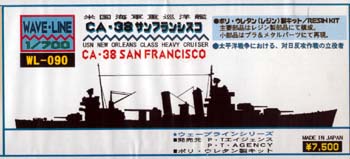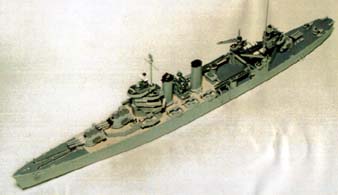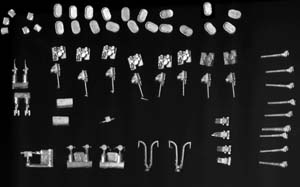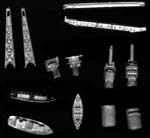 With
the signing of the 1921 Washington Naval treaty the size and armament of various
types of ships that each country was allowed to possess was decreed in specific
tonnages and ratios between navies. The maximum size for heavy cruisers was
set to 10,000 tons and with an 8" main battery. Britain developed the ubiquitous
County Class, Japan the Aoba, Myoko and Takao classes while the US replied
with the Pensacola and Northampton classes
With
the signing of the 1921 Washington Naval treaty the size and armament of various
types of ships that each country was allowed to possess was decreed in specific
tonnages and ratios between navies. The maximum size for heavy cruisers was
set to 10,000 tons and with an 8" main battery. Britain developed the ubiquitous
County Class, Japan the Aoba, Myoko and Takao classes while the US replied
with the Pensacola and Northampton classes
By the time of the London treaty of 1930, further new designs were being considered
to take advantage of the lessons learned with their predecessors. These second-generation
treaty cruisers were ultimately to be known as New Orleans Class and the first
to commission was CA-38, the USS San Francisco. The second ship to bear the
name USS San Francisco, CA38 joined the fleet on 10 February 1934.
 After
the usual working up period in the Pacific she spent her pre-war years in
the waters of the Pacific and Atlantic. December 7, 1941 found her berthed
at Pearl Harbor for a needed refit. At the time of the attack her anti-aircraft
weapons had been removed on preparation for the 1.1" mounts being fitted.
These were added overnight and on the 16th December she sailed to the war
zone where she was to be in the thick of the action for the next year, taking
part in the deadly night battles around Guadalcanal. Following a refit in
early 1943 she then headed north to the Aleutians before returning to the
South Pacific to provide gunfire support for various stages in the strategy
known as 'Island-Hopping'. The end of the war on 14 August 1945 war found
her in Subic Bay, Luzon where she was preparing for the invasion of Japan.
After
the usual working up period in the Pacific she spent her pre-war years in
the waters of the Pacific and Atlantic. December 7, 1941 found her berthed
at Pearl Harbor for a needed refit. At the time of the attack her anti-aircraft
weapons had been removed on preparation for the 1.1" mounts being fitted.
These were added overnight and on the 16th December she sailed to the war
zone where she was to be in the thick of the action for the next year, taking
part in the deadly night battles around Guadalcanal. Following a refit in
early 1943 she then headed north to the Aleutians before returning to the
South Pacific to provide gunfire support for various stages in the strategy
known as 'Island-Hopping'. The end of the war on 14 August 1945 war found
her in Subic Bay, Luzon where she was preparing for the invasion of Japan.
After the war the USS San Francisco was decommissioned and placed in the reserve
fleet on February 10 1947 - 13 years to the day after being commissioned.
Stricken from the Navy list on March 1 1958, she was then scrapped between
December 2, 1960 and May 26, 1962. In 1976 it was announced that a new Los
Angeles class attack submarine, SSN 711, would be given the name San Francisco.
The Kit
The first thing one notices upon opening the box is how securely packed it
is. All of the pieces are in protective packets and are stapled or taped to
the side or bottom of the box. The hull is in bubblewrap, the metal parts
are in small resealable packets while the resin and injected parts are in
larger bags.
 The
hull is cast in one piece and has the deck details (vents, hatches, gun tubs)
moulded into it. The 5" splinter shields are nicely done and were undamaged
- kudos to the packaging mentioned above. My sample is very slightly warped,
exhibiting some sagging of the hull, however this will be easy to fix and
could even be left alone if displayed in an at sea diorama. All of the bridge
levels are provided as separate pieces and are very well cast - in fact the
entire kit has but one medium and five small bubble on the bottom of the hull.
Detail on the bridge is incredible, with the windows and wind deflectors being
particularly well defined. Moving back to the funnels, my aft funnel halves
are ever so slightly misaligned, but this will also be easy to fix with some
careful knife work.
The
hull is cast in one piece and has the deck details (vents, hatches, gun tubs)
moulded into it. The 5" splinter shields are nicely done and were undamaged
- kudos to the packaging mentioned above. My sample is very slightly warped,
exhibiting some sagging of the hull, however this will be easy to fix and
could even be left alone if displayed in an at sea diorama. All of the bridge
levels are provided as separate pieces and are very well cast - in fact the
entire kit has but one medium and five small bubble on the bottom of the hull.
Detail on the bridge is incredible, with the windows and wind deflectors being
particularly well defined. Moving back to the funnels, my aft funnel halves
are ever so slightly misaligned, but this will also be easy to fix with some
careful knife work.
 I
have already cleaned up most of the resin and have to say this is among the
nicest I have yet worked with. It is very soft and easy to carve, yet hard
enough to provide crisp detail. My only disappointment now appears, and that
is the lack of photo-etched parts. This is particularly apparent in the midships
searchlight platform, which is supposed to be an open lattice-work structure,
but is provided as a solid resin casting. Ditto for the catapults that are
in white metal. However Tom's Modelworks provides sets for the New Orleans
Class cruisers as well as Catapult and USN Radars, so all is not lost.
I
have already cleaned up most of the resin and have to say this is among the
nicest I have yet worked with. It is very soft and easy to carve, yet hard
enough to provide crisp detail. My only disappointment now appears, and that
is the lack of photo-etched parts. This is particularly apparent in the midships
searchlight platform, which is supposed to be an open lattice-work structure,
but is provided as a solid resin casting. Ditto for the catapults that are
in white metal. However Tom's Modelworks provides sets for the New Orleans
Class cruisers as well as Catapult and USN Radars, so all is not lost.

 The
white metal parts include the 8" barrels, catapults, cranes, 5" mounts and
guns, life rafts, davits, and boats. All are finely done and the 5" guns are
particularly commended. In addition to the metal parts, Waveline also include
a sprue of Pit Road injected plastic parts which I am assuming is from a 6"
cruiser kit as it contains many parts which are not needed here. However many
of them are useful, and they include the 20mm mounts, 1.1" guns, boats, rafts,
radar and a Curtiss Kingfisher. Three pieces of thin styrene are provided
and they require you to make some of the smaller platforms on your own.
The
white metal parts include the 8" barrels, catapults, cranes, 5" mounts and
guns, life rafts, davits, and boats. All are finely done and the 5" guns are
particularly commended. In addition to the metal parts, Waveline also include
a sprue of Pit Road injected plastic parts which I am assuming is from a 6"
cruiser kit as it contains many parts which are not needed here. However many
of them are useful, and they include the 20mm mounts, 1.1" guns, boats, rafts,
radar and a Curtiss Kingfisher. Three pieces of thin styrene are provided
and they require you to make some of the smaller platforms on your own.
Actual size dimensioned drawings of these parts are included. Instructions
are in Japanese, but include full size drawing of the ship in plan and profile
as well as an exploded drawing showing all of the parts. One final touch is
a decal sheet showing various national markings and numbers.
The kit depicts the San Francisco as she appeared between May and December
1942 and as such very accurately portrays her. Sadly she only wore one scheme
during this time - Measure 11, which was an overall 'Sea Blue' on all vertical
surfaces and 'Deck Blue' decks. If the more 'racy' MS 33/13D is desired, drastic
modifications to the bridge and searchlight platforms will be required - I
have already scratchbuilt her in this configuration in 1/400 scale, so will
stay with the kit this time.
Conclusion
This is a kit I am actually itching to build and can't wait to finish the
ones I am presently working on to get at it - need a higher recommendation
be made? The lack of PE is a strike against it, but everything else more then
makes up for it. Indeed built OOB it will still be an attractive addition
to anyone's fleet. Thanks to HobbyLink Japan for the review sample.
Copyright © SMML 2004